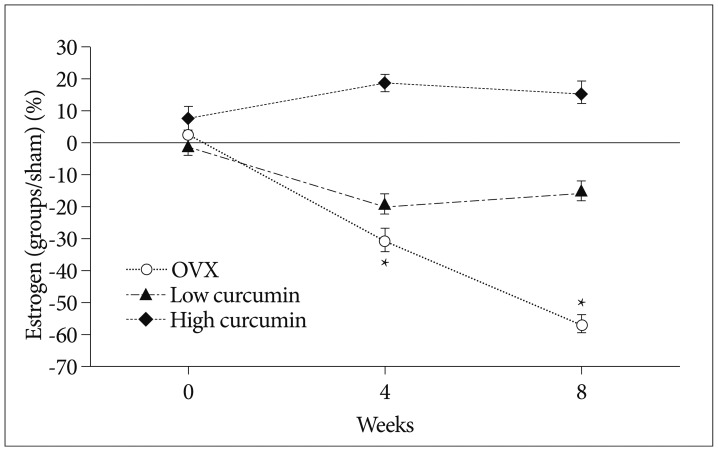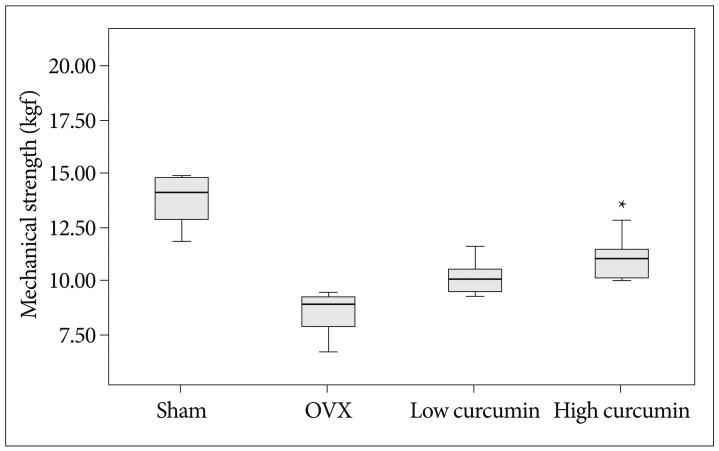J Korean Neurosurg Soc.
2013 Dec;54(6):461-466. 10.3340/jkns.2013.54.6.461.
Therapeutic Advantages of Treatment of High-Dose Curcumin in the Ovariectomized Rat
- Affiliations
-
- 1Department of Neurosurgery, School of Medicine, Kyungpook National University, Daegu, Korea. jhwang@knu.ac.kr
- 2Department of Anesthesiology and Pain Medicine, School of Dentistry, Kyungpook National University, Daegu, Korea.
- KMID: 2190940
- DOI: http://doi.org/10.3340/jkns.2013.54.6.461
Abstract
OBJECTIVE
Although curcumin has a protective effect on bone remodeling, appropriate therapeutic concentrations of curcumin are not well known as therapeutic drugs for osteoporosis. The purpose of this study was to compare the bone sparing effect of treatment of low-dose and high-dose curcumin after ovariectomy in rats.
METHODS
Forty female Sprague-Dawley rats underwent either a sham operation (the sham group) or bilateral ovariectomy (OVX). The ovariectomized animals were randomly distributed among three groups; untreated OVX group, low-dose (10 mg/kg) curcumin administered group, and high-dose (50 mg/kg) curcumin group. At 4 and 8 weeks after surgery, serum biochemical markers of bone turnover were analyzed. Bone histomorphometric parameters of the 4th lumbar vertebrae were determined by micro-computed tomography (CT). In addition, mechanical strength was determined by a three-point bending test.
RESULTS
High-dose curcumin group showed significantly lower osteocalcin, alkaline phosphatase, and the telopeptide fragment of type I collagen C-terminus concentration at 4 and 8 weeks compared with the untreated OVX group as well as low-dose curcumin group. In the analyses of micro-CT scans of 4th lumbar vertebrae, the high-dose curcumin treated group showed a significant increase in bone mineral densities (p=0.028) and cortical bone mineral densities (p=0.036) compared with the low-dose curcumin treated group. Only high-dose curcumin treated group had a significant increase of mechanical strength compared with the untreated OVX group (p=0.015).
CONCLUSION
The present study results demonstrat that a high-dose curcumin has therapeutic advantages over a low-dose curcumin of an antiresorptive effect on bone remodeling and improving bone mechanical strength.
Keyword
MeSH Terms
Figure
Reference
-
1. Burge R, Dawson-Hughes B, Solomon DH, Wong JB, King A, Tosteson A. Incidence and economic burden of osteoporosis-related fractures in the United States, 2005-2025. J Bone Miner Res. 2007; 22:465–475. PMID: 17144789.
Article2. Cheng AL, Hsu CH, Lin JK, Hsu MM, Ho YF, Shen TS, et al. Phase I clinical trial of curcumin, a chemopreventive agent, in patients with high-risk or pre-malignant lesions. Anticancer Res. 2001; 21:2895–2900. PMID: 11712783.3. Cho DC, Kim KT, Jeon Y, Sung JK. A synergistic bone sparing effect of curcumin and alendronate in ovariectomized rat. Acta Neurochir (Wien). 2012; 154:2215–2223. PMID: 23053289.
Article4. Fleisch H. Bisphosphonates : mechanisms of action. Endocr Rev. 1998; 19:80–100. PMID: 9494781.5. Folwarczna J, Zych M, Trzeciak HI. Effects of curcumin on the skeletal system in rats. Pharmacol Rep. 2010; 62:900–909. PMID: 21098873.
Article6. French DL, Muir JM, Webber CE. The ovariectomized, mature rat model of postmenopausal osteoporosis : an assessment of the bone sparing effects of curcumin. Phytomedicine. 2008; 15:1069–1078. PMID: 18693096.
Article7. Kashii M, Hashimoto J, Nakano T, Umakoshi Y, Yoshikawa H. Alendronate treatment promotes bone formation with a less anisotropic microstructure during intramembranous ossification in rats. J Bone Miner Metab. 2008; 26:24–33. PMID: 18095060.
Article8. Odvina CV, Zerwekh JE, Rao DS, Maalouf N, Gottschalk FA, Pak CY. Severely suppressed bone turnover : a potential complication of alendronate therapy. J Clin Endocrinol Metab. 2005; 90:1294–1301. PMID: 15598694.
Article9. Oh S, Kyung TW, Choi HS. Curcumin inhibits osteoclastogenesis by decreasing receptor activator of nuclear factor-kappaB ligand (RANKL) in bone marrow stromal cells. Mol Cells. 2008; 26:486–489. PMID: 18719352.10. Ozaki K, Kawata Y, Amano S, Hanazawa S. Stimulatory effect of curcumin on osteoclast apoptosis. Biochem Pharmacol. 2000; 59:1577–1581. PMID: 10799655.
Article11. Palumbo C, Ferretti M, Bertoni L, Cavani F, Resca E, Casolari B, et al. Influence of ferutinin on bone metabolism in ovariectomized rats. I: role in preventing osteoporosis. J Bone Miner Metab. 2009; 27:538–545. PMID: 19333679.
Article12. Park SB, Lee YJ, Chung CK. Bone mineral density changes after ovariectomy in rats as an osteopenic model : stepwise description of double dorso-lateral approach. J Korean Neurosurg Soc. 2010; 48:309–312. PMID: 21113356.
Article13. Park SK, Oh S, Shin HK, Kim SH, Ham J, Song JS, et al. Synthesis of substituted triazolyl curcumin mimics that inhibit RANKL-induced osteoclastogenesis. Bioorg Med Chem Lett. 2011; 21:3573–3577. PMID: 21570847.
Article14. Ruggiero SL, Mehrotra B, Rosenberg TJ, Engroff SL. Osteonecrosis of the jaws associated with the use of bisphosphonates : a review of 63 cases. J Oral Maxillofac Surg. 2004; 62:527–534. PMID: 15122554.
Article15. Schneider JP. Should bisphosphonates be continued indefinitely? An unusual fracture in a healthy woman on long-term alendronate. Geriatrics. 2006; 61:31–33. PMID: 16405362.16. Sheng ZF, Dai RC, Wang P, Yao XF, Feng XQ, Fang LN, et al. [Nanomechanical properties of vertebral trabeculae in ovariectomized rats]. Zhonghua Yi Xue Za Zhi. 2006; 86:515–519. PMID: 16681878.17. Shin YH, Cho DC, Yu SH, Kim KT, Cho HJ, Sung JK. Histomorphometric analysis of the spine and femur in ovariectomized rats using micro-computed tomographic scan. J Korean Neurosurg Soc. 2012; 52:1–6. PMID: 22993670.
Article18. Shiraishi A, Miyabe S, Nakano T, Umakoshi Y, Ito M, Mihara M. The combination therapy with alfacalcidol and risedronate improves the mechanical property in lumbar spine by affecting the material properties in an ovariectomized rat model of osteoporosis. BMC Musculoskelet Disord. 2009; 10:66. PMID: 19527501.
Article19. Shishodia S, Sethi G, Aggarwal BB. Curcumin : getting back to the roots. Ann N Y Acad Sci. 2005; 1056:206–217. PMID: 16387689.20. Szulc P, Delmas PD. Biochemical markers of bone turnover : potential use in the investigation and management of postmenopausal osteoporosis. Osteoporos Int. 2008; 19:1683–1704. PMID: 18629570.
Article21. Watts NB, Diab DL. Long-term use of bisphosphonates in osteoporosis. J Clin Endocrinol Metab. 2010; 95:1555–1565. PMID: 20173017.
Article22. Yang KY, Lin LC, Tseng TY, Wang SC, Tsai TH. Oral bioavailability of curcumin in rat and the herbal analysis from Curcuma longa by LC-MS/MS. J Chromatogr B Analyt Technol Biomed Life Sci. 2007; 853:183–189.
Article
- Full Text Links
- Actions
-
Cited
- CITED
-
- Close
- Share
- Similar articles
-
- The Therapeutic Effects of Combination Therapy with Curcumin and Alendronate on Spine Fusion Surgery in the Ovariectomized Rats
- Analgesic Effects of Intrathecal Curcumin in the Rat Formalin Test
- Recent Developments in Delivery, Bioavailability, Absorption and Metabolism of Curcumin: the Golden Pigment from Golden Spice
- Preparation and Biodistribution Assessment of 177Lu-curcumin as a Possible Therapeutic Agent
- The Attenuation of Pain Behavior and Serum COX-2 Concentration by Curcumin in a Rat Model of Neuropathic Pain






